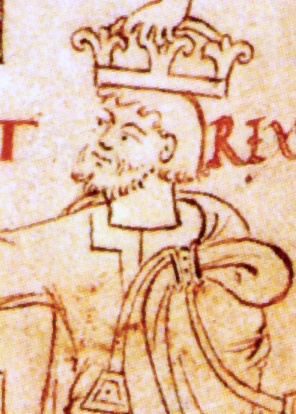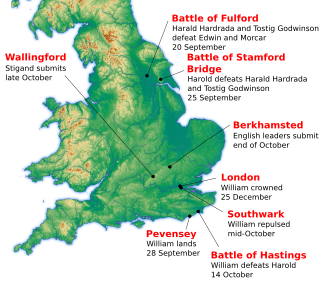Related Research Articles

Harold Godwinson, also called Harold II, was the last crowned Anglo-Saxon English king. Harold reigned from 6 January 1066 until his death at the Battle of Hastings, fighting the Norman invaders led by William the Conqueror during the Norman Conquest of England. His death marked the end of Anglo-Saxon rule over England.
Godwin of Wessex was an English nobleman who became one of the most powerful earls in England under the Danish king Cnut the Great and his successors. Cnut made Godwin the first Earl of Wessex. Godwin was the father of King Harold II and of Edith of Wessex, who in 1045 married King Edward the Confessor.

Emma of Normandy was a Norman-born noblewoman who became the English, Danish, and Norwegian queen through her marriages to the Anglo-Saxon king Æthelred the Unready and the Danish king Cnut the Great. A daughter of the Norman ruler Richard the Fearless and Gunnor, she was Queen of the English during her marriage to King Æthelred from 1002 to 1016, except during a brief interruption in 1013–14 when the Danish king Sweyn Forkbeard occupied the English throne. Æthelred died in 1016, and Emma married Sweyn's son Cnut. As Cnut's wife, she was Queen of England from their marriage in 1017, Queen of Denmark from 1018, and Queen of Norway from 1028 until Cnut died in 1035.

Edward the Confessor was an Anglo-Saxon English king and saint. Usually considered the last king of the House of Wessex, he ruled from 1042 until his death in 1066.

Sweyn Forkbeard was King of Denmark from 986 until his death, King of England for five weeks from December 1013 until his death, and King of Norway from 999/1000 until 1013/14. He was the father of King Harald II of Denmark, King Cnut the Great, and Queen Estrid Svendsdatter.

Cnut, also known as Canute and with the epithet the Great, was King of England from 1016, King of Denmark from 1018, and King of Norway from 1028 until his death in 1035. The three kingdoms united under Cnut's rule are referred to together as the North Sea Empire.

The Norman Conquest was the 11th-century invasion and occupation of England by an army made up of thousands of Norman, Breton, Flemish, and French troops, all led by the Duke of Normandy, later styled William the Conqueror.
Tostig Godwinson was an Anglo-Saxon Earl of Northumbria and brother of King Harold Godwinson. After being exiled by his brother, Tostig supported the Norwegian king Harald Hardrada's invasion of England, and was killed alongside Hardrada at the Battle of Stamford Bridge in 1066.
Lyfing of Winchester was an Anglo-Saxon prelate who served as Bishop of Worcester, Bishop of Crediton and Bishop of Cornwall.
Gytha Thorkelsdóttir, also called Githa, was a Danish noblewoman. She was the wife of Godwin, Earl of Wessex and the mother of King Harold Godwinson and of Edith of Wessex, who was the queen consort of King Edward the Confessor.
Thorgils Sprakalegg was a Danish nobleman whose children were active in the politics of Denmark and England in the early 11th century and who was grandfather of kings of both nations. Little is recorded about Thorgils in historical texts outside of his place in the genealogy of his children or grandchildren. Thorgils' cognomen Sprakalägg can be translated into English as "Break-leg" or "Strut-leg".

Edith of Wessex was Queen of England from her marriage to Edward the Confessor in 1045 until Edward died in 1066. Unlike most English queens in the 10th and 11th centuries, she was crowned. The principal source on her life is a work she herself commissioned, the Vita Ædwardi Regis or the Life of King Edward who rests at Westminster, which is inevitably biased.

Ulf Thorgilsson, commonly known as Ulf Jarl, was a Danish jarl of Skåne and regent of Denmark. Ulf was the son of Thorgil Sprakling and the father of King Sweyn II of Denmark and thus the progenitor of the House of Estridsen, which would rule Denmark from 1047 to 1375, which was also sometimes, specially in Swedish sources, referred to as the Ulfinger dynasty to honor him.
Sweyn Godwinson, also spelled Swein, was the eldest son of Earl Godwin of Wessex, and brother of Harold II of England.
Estrid Svendsdatter of Denmark, was a Danish princess and titular queen, a Russian princess and, possibly, duchess of Normandy by marriage. She was the daughter of Sweyn Forkbeard and perhaps Gunhild of Wenden and half-sister of Cnut the Great. By Ulf Jarl, she was the mother of the later King Sweyn II Estridson and Beorn Estrithson. The dynasty that ruled Denmark in 1047–1412 was named after her. Though never a ruler or wife of a king, she was known in Denmark as queen during her son's reign.

The House of Godwin is an Anglo-Saxon family who were one of the leading noble families in England during the last fifty years before the Norman Conquest. Its most famous member was Harold Godwinson, King of England for nine months in 1066.

The Danish House of Knýtlinga was a ruling royal house in Middle Age Scandinavia and England. Its most famous king was Cnut the Great, who gave his name to this dynasty. Other notable members were Cnut's father Sweyn Forkbeard, grandfather Harald Bluetooth, and sons Harthacnut, Harold Harefoot, and Svein Knutsson. It has also been called the House of Canute, the House of Denmark, the House of Gorm, or the Jelling dynasty.
Godwin or Godwine was a son, probably the eldest son, of Harold Godwinson, King of England. He was driven into exile in Dublin, along with two of his brothers, by the Norman conquest of England, and from there he twice led expeditions to south-western England, but with little success.
Magnus was a son of Harold Godwinson, King of England. He was, in all likelihood, driven into exile in Dublin by the Norman conquest of England, along with two of his brothers, and from there took part in one, or perhaps two, expeditions to south-western England, but with little military success. They probably cost him his life.
There were two Danish attacks on Norman England. The first was an invasion in 1069–1070 conducted in alliance with various English rebels which succeeded in taking first York and then Ely before the Danes finally accepted a bribe to leave the country. The second was a large-scale raid in 1075, intended to support the Revolt of the Earls, in which the Lincolnshire coast and York were both ravaged. A third attack was planned in 1085, and a large invasion fleet comprising Danish, Flemish and Norwegian vessels was gathered, but it never sailed. All three attacks were motivated by a claim on the English throne asserted originally by Cnut the Great's nephew Sweyn II, king of Denmark, and maintained by later Danish kings until as late as the 13th century, but neither of the two realised attacks succeeded in making Sweyn's claim good, or indeed gained anything for the Danes apart from a certain amount of plunder.
References
- 1 2 3 4 Williams, Ann. "Beorn Estrithson". Oxford Dictionary of National Biography (online ed.). Oxford University Press. doi:10.1093/ref:odnb/2182.(Subscription or UK public library membership required.)
- ↑ Walker Harold p. 22
- ↑ Walker Harold pp. 24–25
- ↑ P. A. Munch (1855), Det Norske Folks Historie, vol. 5, no. 5, p. 287